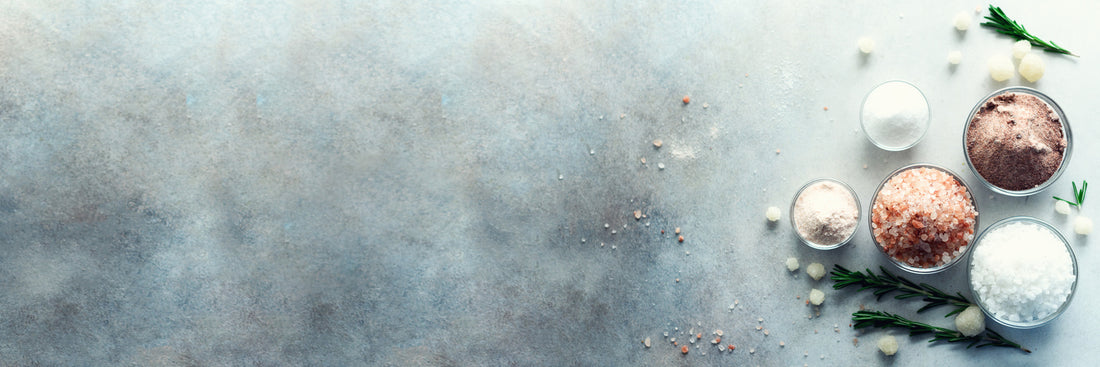Sea salt is experiencing a surging demand as more people discover its unique flavours and health benefits over regular table salt. With so many varieties available, it's important to understand what makes sea salt special, how it's produced, and how to choose the best types. This guide explores the world of sea salt, with a special focus on distinctive UK sea salts and the gifts they offer. Let's dive into this saltwater treasure!
Introduction to Sea Salt
Sea salt is salt that is produced by the evaporation of seawater. It's harvested in coastal regions around the world where seawater can be channeled into large salt pans and allowed to evaporate, leaving behind pure, unrefined salt crystals.
Unlike table salt, sea salt contains trace minerals like potassium, iron, and zinc that are absorbed from the ocean. Sea salts contain a much larger percentage of these trace minerals than refined sea salts, more closely reflecting the sea it was sourced from. The flavours and textures can vary greatly depending on the water source and harvesting techniques.
Sea Salt vs. Table Salt: Understanding the Difference
In contrast to the bright complexity of sea salt, basic table salt undergoes heavy processing that bleaches out minerals and texture. The delicate flakes of sea salt cling to your fingers as you pinch them, while table salt slips through your fingers like dry sand. This results in sea salt having more nuanced flavours and colours.
Production Process of Sea Salt
Harvesting Sea Salt: Traditional and Modern Methods
Sea salt is harvested through evaporation methods that have changed little over the centuries. Traditional production involves channeling ocean water into a network of shallow clay-lined ponds and allowing the sun and wind to evaporate the water over time, leaving behind salt crystals. In some regions, production has been modernized with pumps and equipment to expedite evaporation. However, solar and wind methods are still favoured for retaining purity.
The Role of Geography in Sea Salt Production
The unique mineral content of sea salt is influenced by the geology and climate of where it's produced. Areas with high humidity, steady winds, and maximum sun exposure create optimal evaporation conditions. Coastal areas situated near mineral-rich mountains or river deposits absorb those minerals into the ocean - which then pass into the sea salt. This gives each sea salt region a distinctive nutritional profile.
Types of Sea Salt
A Closer Look at Himalayan, Celtic, and Other Sea Salts
There are numerous varieties of sea salt harvested from different coastal regions. Himalayan pink salt is hand-mined from the Khewra Salt Mine in Pakistan. It has a pink hue from iron oxide and over 80 trace minerals. Celtic sea salt originates from coastal France and has a grayish color and moist texture. Hawaiian sea salt boasts a reddish tint from volcanic clay and robust, briny flavor from Pacific waters.
Spotlight on UK's Sea Salt Varieties
The UK is home to a thriving sea salt industry, producing over half a million tons annually. Coastal areas like Cornwall, Anglesey, and the Hebrides host centuries-old sea salt works. Unique regional geology and seawater imbue UK sea salts with diverse mineral content and complex flavours. Popular varieties include Halen Môn from Wales, Cornish sea salt, Piranske Soline from Northern Ireland, and Isle of Skye sea salt from Scotland.
Isle of Skye Sea Salt: A Scottish Treasure
A standout among UK sea salts is Isle of Skye Sea Salt, produced sustainably off the Scottish west coast. Isle of Skye sea salt glitters like snowflakes yet delivers an explosion of briny ocean flavour. The sea salt is harvested using solar evaporation in the shadow of the Cuillin Hills, whose mineral-rich deposits influence the 154m year-old seawater. This lends the salt its dazzling pure white colour and exceptionally bright, well-rounded flavour. The sea salt has a soft, delicate crystal size, perfect for enhancing the flavours of meat, fish, and veggies.
Uses of Sea Salt
Culinary Delights: Enhancing Flavours with Sea Salt
Sea salt is a versatile ingredient that can elevate flavours from savoury meats, fish, and vegetables to baked goods, chocolates, and cocktails. See how a sprinkling of salt intensifies the earthy sweetness of baked potatoes, makes grilled meats sing, and balances tart lemon curd tarts and salted caramel. The salt crystals provide bursts of concentrated saltiness and mineral flavours. Sea salt's bright taste also balances bitterness and sourness. For those seeking more adventurous options, explore our articles on smoked sea salt and seaweed sea salt to discover even more exciting flavour profiles.
Beyond Cooking: Sea Salt in Skincare and Therapy
In addition to its use as sea salt for cooking, sea salt also offers benefits for skincare and therapeutic bathing. Mixing sea salt with oil scrubs exfoliates and nourishes skin. Adding it to bathwater creates a mineral-rich soak to detoxify and relax sore muscles. The magnesium in sea salt also helps relieve stress. Himalayan salt lamps purify air through hygroscopy.
Benefits of Sea Salt
Health Benefits: A Nutritional Perspective
Unlike table salt, sea salt contains dozens of trace minerals from calcium and magnesium to potassium and iron. This provides a broader spectrum of nutrients than just sodium chloride. Minerals like potassium help balance healthy fluid levels in the body. The variety of minerals also makes sea salt easier for the body to metabolize than highly refined salts. Always enjoy sea salt in moderation as part of a balanced diet.
The Balance of Minerals: Why It Matters
One-note table salt marches to the beat of sodium chloride alone, while sea salt's mineral medley creates a symphony of flavours. Table salt is almost entirely sodium chloride, lacking beneficial minerals that help regulate absorption in the body. Sea salt's balance of trace minerals and salts makes it less taxing on the body compared to refined salt's singular concentration. This allows the salty taste to bloom without being overpowering. When buying sea salt, check that no minerals are artificially added back in.
Environmental Impact
Sustainable Practices in Sea Salt Harvesting
With careful harvesting methods, sea salt can be an eco-friendly alternative to conventional table salt. Solar evaporation techniques rely on renewable solar and wind energy. Some salt farms use shallow ponds, which require less movement and infrastructure disruption. Supporting local sea salt producers also reduces environmental toll from transportation.
Choosing Eco-Friendly Sea Salt Brands
When selecting an eco-friendly sea salt brand, look for practices that preserve the salt's purity and the local environment. One of the biggest green advantages of Isle of Skye Sea Salt is that they do not use any electrical heating or fans, relying solely on the sun and wind for evaporation - which is quite unusual for a sea salt company in a cooler climate like Scotland. This also means their salt goes through an unrefined process without boiling the seawater, resulting in around 15% more trace minerals than typical refined sea salts. This greener and unrefined solar and wind evaporation method, without any electrical inputs, is Isle of Skye's biggest sustainable advantage. Other good choices are small batch artisanal salts directly sourced from traditional solar salt farms that avoid chemical processing and prioritize fair labor practices. Supporting these producers reduces environmental impact.
Conclusion: The Versatility and Vitality of Sea Salt
Sea salt offers a treasure trove of textures and flavours beyond everyday table salt. With careful production methods, sea salt can provide a nutritional boost over refined salts while adding gourmet flair to recipes. From Hawaiian black lava sea salt to Cornish smoked varieties, specialty sea salts are the new spice rack essential. Allow the complex beauty of sea salt to enhance your cooking and wellness.

